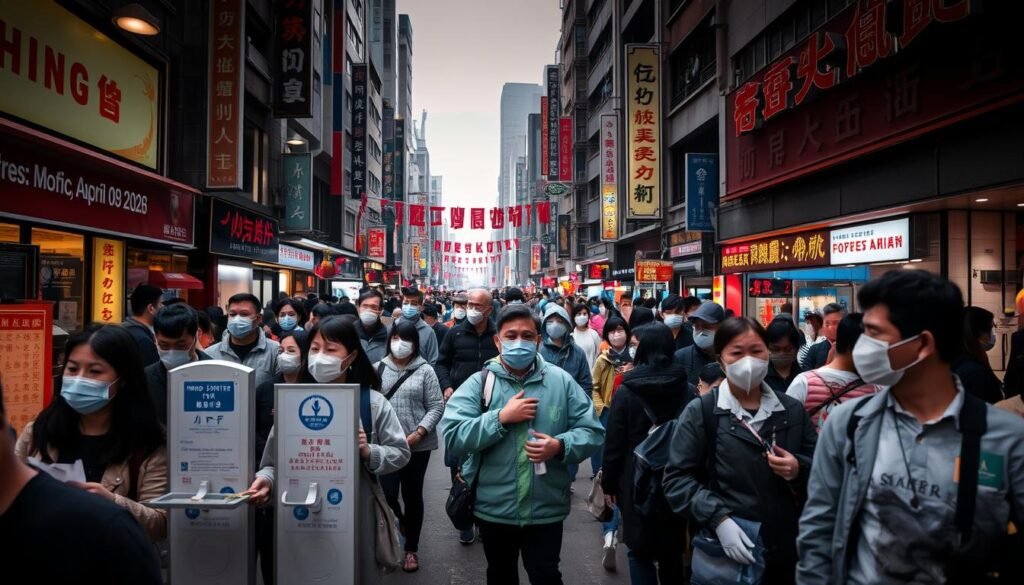
It’s important to stay informed about the hmpv outbreak in china. This includes knowing its symptoms and how it spreads. The virus affects people of all ages, but young children, the elderly, and those with weak immune systems are at higher risk.
Understanding how hmpv spreads and taking preventive steps can lower your risk of getting infected. This is similar to how we prevent the spread of coronavirus.
Prevention is key in fighting the hmpv outbreak in china. By knowing the symptoms and how it spreads, you can protect yourself and your family. Stay updated on the latest news and take steps to stop the virus from spreading.
Let’s look at the main points. The hmpv outbreak in china is a big worry, with most cases in people under 14, mainly in northern provinces. The symptoms of hmpv can be like those of other respiratory illnesses. It’s important to know how to tell them apart and act quickly.
Key Takeaways
- The hmpv outbreak in china is mainly in people under 14 in northern provinces.
- HMPV causes infections in the upper and lower respiratory system, affecting all ages.
- Young children, the elderly, and those with weak immune systems are most at risk.
- Prevention, like washing hands and staying away from sick people, can help prevent infection.
- Knowing the symptoms and spread of hmpv is key to preventing its spread.
- There’s no specific treatment or vaccine for hmpv, so focusing on symptom relief and prevention is important.
Breaking Down the Current HMPV Situation in China
The hmpv outbreak in China has caused worry for health officials and the public. Reports show the situation is being watched closely. The focus is on the timeline and the affected regions.
The Chinese government is working hard to stop the virus. They are raising awareness and taking steps to prevent its spread.
The hmpv outbreak has hit children in northern China hard. The US Centers for Disease Control and Prevention (CDC) says HMPV usually causes lung infections. This winter, respiratory infections in China are not as common as before. But, HMPV cases among kids 14 and under are going up.
Overview of the Outbreak Timeline
Cases of the virus have been reported across the country. The World Health Organization’s data shows more acute respiratory infections in China, including HMPV, from December 16-22. Reuters reported a big increase in HMPV cases, mainly among kids under 14 in northern provinces.
Affected Regions and Population Groups
The affected regions in China are northern provinces, where the virus is spreading fast among children. The American Lung Association says kids, the elderly, and those with weak immune systems are at high risk. The CDC suggests washing hands, avoiding sick people, and staying home when sick.
Initial Response Measures
The Chinese government is fighting the virus with awareness and preventive steps. There’s no vaccine for HMPV, and treatment aims to ease symptoms and keep vital signs stable. How long someone is sick with HMPV varies, but it’s like other respiratory infections.
Understanding Human Metapneumovirus (HMPV)
Human metapneumovirus, or HMPV, affects people of all ages. It’s most common in young children and the elderly. This virus was discovered in 2001 and causes upper and lower respiratory infections.
Symptoms of HMPV include cough, fever, and sometimes pneumonia. There’s no specific treatment or vaccine for it. Instead, doctors focus on easing symptoms. Testing for HMPV is rare, except in severe cases or during outbreaks.
Some important facts about HMPV are:
- HMPV spreads in late winter and spring, showing a seasonal pattern.
- Young children, the elderly, and those with weak immune systems face higher risks.
- The virus’s incubation period is about three to six days.
To prevent HMPV, you can wash your hands, wear masks, and stay home when sick. These steps help reduce the risk of respiratory illnesses like HMPV.
| Age Group | Risk Level |
|---|---|
| Young Children | High |
| Elderly | High |
| Individuals with compromised immune systems | High |
Key Symptoms to Watch For
Recognizing the key symptoms of Human Metapneumovirus (HMPV) is key for early treatment. Common signs include cough, fever, and nasal congestion. Shortness of breath can also occur. In severe cases, it may lead to bronchitis or pneumonia.
It’s important to watch for HMPV symptoms 3-6 days after exposure. These can be mild or severe. Look out for wheezing, sore throat, and a runny or stuffy nose. If you notice these, seek medical help right away.
Here are some common symptoms of HMPV to watch for:
- Cough
- Fever
- Nasal congestion
- Shortness of breath
- Wheezing
- Sore throat
If you’re experiencing any of these symptoms, see a doctor. This is true, even if they seem mild or severe.
In severe cases, HMPV can cause bronchitis or pneumonia. Be aware of these severe case indicators. If you or someone you know has these symptoms, get medical help right away.
| Symptom | Description |
|---|---|
| Cough | A dry or wet cough that may produce mucus |
| Fever | A high temperature, usually above 100.4°F (38°C) |
| Nasal congestion | Stuffy or runny nose, which can lead to sinus pressure and headaches |
| Shortness of breath | Ddifficulty breathing or feeling winded even when sitting or doing light activities |
How HMPV Spreads in Communities
Understanding how it spreads is key to fighting Human Metapneumovirus (HMPV). The CDC says it spreads through coughing or sneezing, touching, and contaminated surfaces. Knowing this helps us fight it better.
In crowded places, hmpv spread can grow fast. To stop it, wash your hands often, stay away from the sick, and don’t touch your face. These steps help keep your community safe.
Here are some ways to stop HMPV from spreading:
- Wash your hands often with soap and water
- Avoid touching your face, like your mouth, nose, and eyes
- Stay away from people who are sick
- Avoid sharing food, drinks, or utensils with others
By knowing how it spreads and taking steps to prevent it, you protect yourself and others. Remember, stopping it early keeps everyone safe.
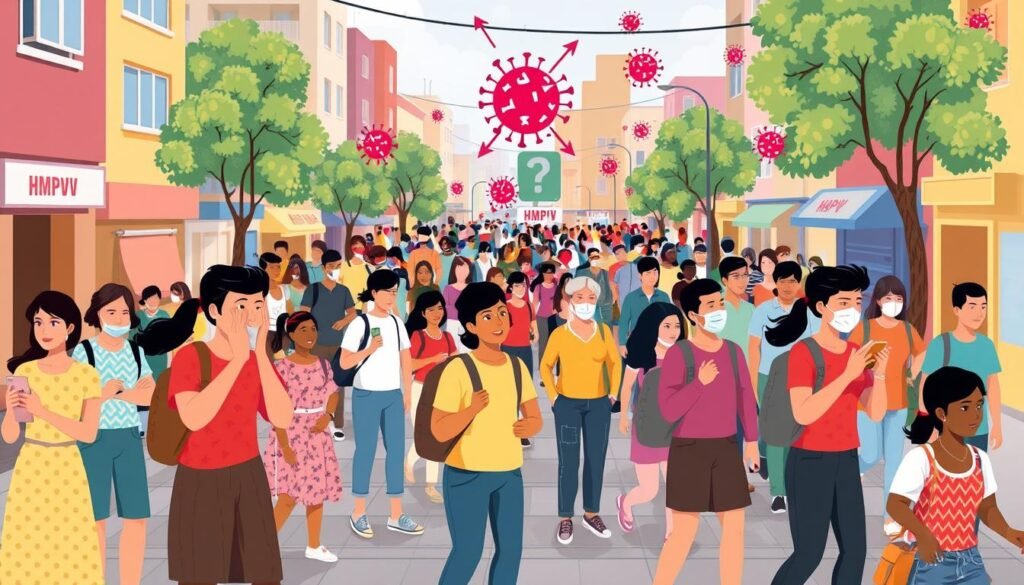
The CDC says HMPV spreads through coughing, touching, and contaminated surfaces. Knowing this helps you prevent it in your community.
| Mode of Transmission | Description |
|---|---|
| Droplets from coughing and sneezing | HMPV can spread through respiratory droplets that are released when an infected person coughs or sneezes |
| Human contact | HMPV can spread through close contact with an infected person, such as touching or shaking hands |
| Contaminated surfaces | HMPV can spread through touching contaminated surfaces, followed by touching the mouth, nose, or eyes |
Distinguishing HMPV from Other Respiratory Illnesses
It can be hard to figure out what’s causing your respiratory symptoms. Distinguishing HMPV from other illnesses like COVID-19, influenza, and the common cold is key. HMPV is a common virus that affects the lungs, mainly in kids and older people.
To distinguish HMPV from other illnesses, knowing the symptoms is important. HMPV usually causes mild symptoms but can sometimes lead to serious lung infections.
Comparison with COVID-19
HMPV and COVID-19 are both respiratory viruses, but they differ. COVID-19 can spread all year, while HMPV is more common in winter and spring. Knowing these differences helps in creating better prevention and treatment plans.
Comparison with Influenza and Common Cold
HMPV can be confused with influenza or the common cold because their symptoms are similar. But HMPV often causes more severe lung infections, mainly in those who are more vulnerable. By distinguishing HMPV from other illnesses, doctors can give more focused care and treatment.
Risk Factors and Vulnerable Populations
Some groups face a higher risk of hmpv infection and severe outcomes. These include young kids, older adults, and people with weak immune systems or chronic lung issues. Knowing the risk factors helps us focus on prevention and treatment.
The CDC says kids under five, and those over 65, are at greater risk. Also, people with weak immune systems or lung diseases like asthma or COPD are more likely to get severe hmpv.
To lower the risk of getting sick, it’s key to take preventive steps. This includes:
- Practicing good hygiene, like washing hands often
- Staying away from people who are sick
- Cleaning surfaces and objects that might be dirty
- Wearing masks in crowded places
- Keeping a healthy lifestyle to boost immunity
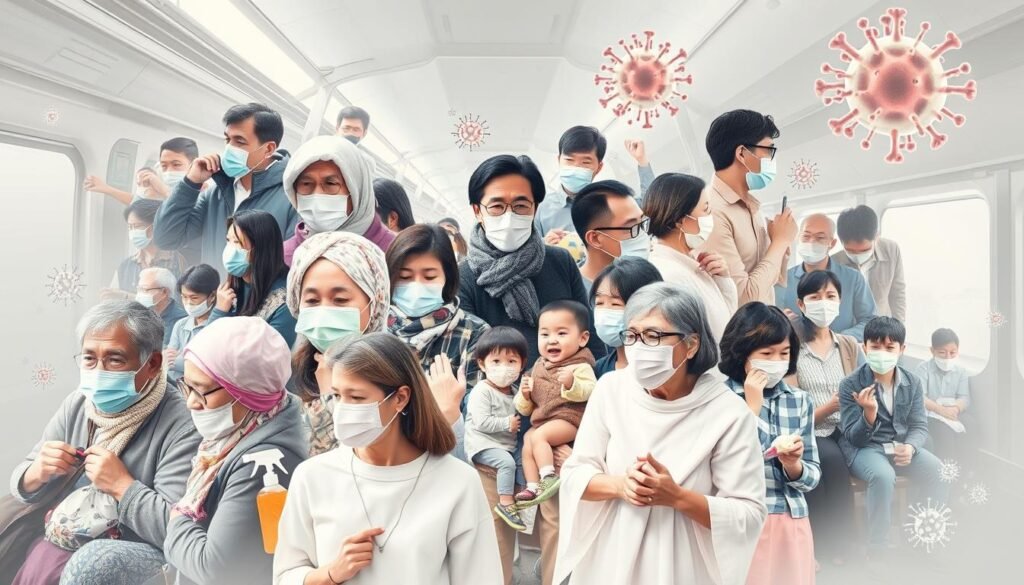
By knowing the risk factors and protecting vulnerable populations, we can lessen the impact of hmpv. This helps improve public health.
| Population Group | Risk Level | Preventive Measures |
|---|---|---|
| Young Children | High | Practicing good hygiene, avoiding close contact with sick individuals |
| Older Adults | High | Disinfecting surfaces, wearing masks in crowded areas |
| Individuals with Weakened Immune Systems | High | Boosting immunity through a healthy lifestyle, avoiding close contact with sick individuals |
Prevention Measures and Safety Guidelines
To lower the chance of getting HMPV, it’s key to use prevention measures and stick to safety guidelines. This means washing your hands often with soap and water for 20 seconds. Also, avoid touching your face with dirty hands and wear masks in busy areas.
Keeping your environment clean is also important. Clean often-touched surfaces and stay home if you’re sick. Even though there’s no vaccination for HMPV, these steps can greatly lower your risk.
- Washing hands frequently with soap and water
- Avoiding close contact with individuals who are sick
- Staying home when you are sick to prevent spreading the illness
- Regularly cleaning and disinfecting frequently touched surfaces
By sticking to these safety guidelines and using good personal protection, you can lower your risk of getting HMPV. This helps stop the virus from spreading in your area.
Global Health Response and Monitoring
The world is coming together to fight the HMPV outbreak. International and national health groups are working hard. They aim to monitor the situation and offer support. This includes better surveillance, improved testing, and spreading the word to doctors and everyone else.
The World Health Organization (WHO) is leading the charge. They give advice and help to countries hit by HMPV. The WHO also keeps an eye on how fast HMPV is spreading. They find out where more help is needed.
To stop HMPV, several steps are being taken:
- Watching for more respiratory illnesses
- Getting better at testing for HMPV
- Telling doctors and people about HMPV risks and signs
- Keeping healthcare places clean to stop infections
The goal is to slow down HMPV, protect those who are most at risk, and ease the burden on hospitals. By working together, we can keep an eye on things and stop HMPV from spreading more.
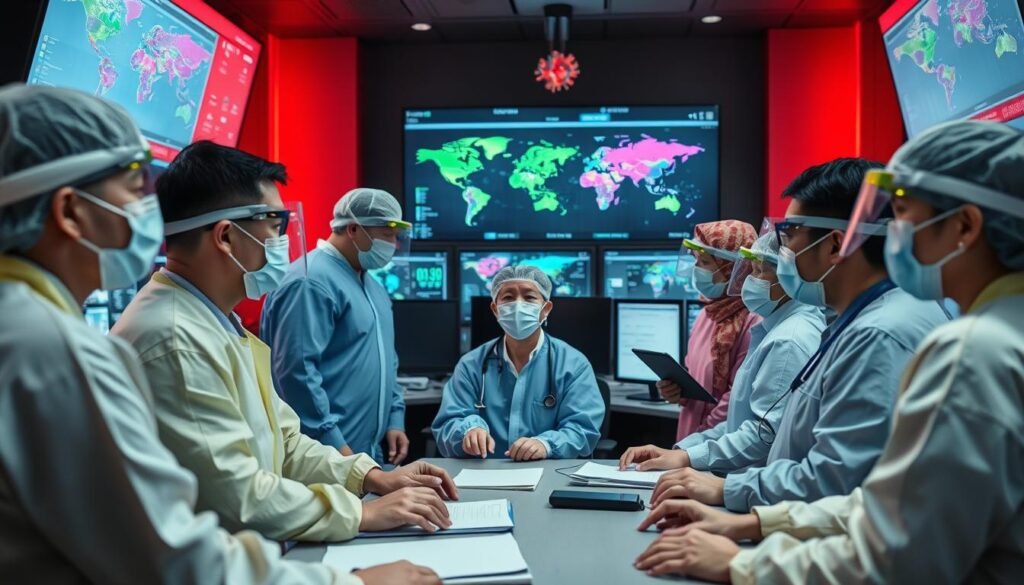
Treatment Options and Medical Care
Treating HMPV focuses on easing symptoms and helping the body heal naturally. The Cleveland Clinic notes there’s no specific antiviral treatment or vaccine for HMPV. Instead, available treatments aim to manage symptoms. This includes staying hydrated, resting well, and using over-the-counter meds for pain, congestion, and fever.
For those with mild symptoms, home care is often enough. But, if symptoms are severe, hospital care might be needed for oxygen therapy or intravenous fluids. It’s key to see a doctor if symptoms get worse or if breathing becomes hard.
Here are some general tips for treatment options:
- Stay hydrated by drinking plenty of fluids
- Get plenty of rest to help your body recover
- Use over-the-counter medications to manage pain, congestion, and fever
Knowing the treatment options and medical care for HMPV helps you manage symptoms and aid in recovery. Always talk to a healthcare professional for advice tailored to you.
| Treatment Option | Description |
|---|---|
| Home Care | Rest, hydration, and over-the-counter medications |
| Hospital Care | Oxygen therapy, intravenous fluids, and close monitoring |
Impact on International Travel and Trade
The recent surge in HMPV cases in China has raised concerns about the impact on international travel and trade. Countries are taking steps to stop HMPV from spreading during travel. This includes more checks at airports, which might cause delays.
The trade sector is also feeling the effects. Countries might limit imports and exports to stop HMPV. This could hurt the economy and disrupt global supply chains. It’s important for countries to work together to lessen these impacts and stop the virus spread.
Measures to reduce the impact of HMPV include:
- Enhanced surveillance and screening at airports and border crossings
- Increased availability of diagnostic tests and antiviral treatments
- Public awareness campaigns to promote hygiene and vaccination awareness
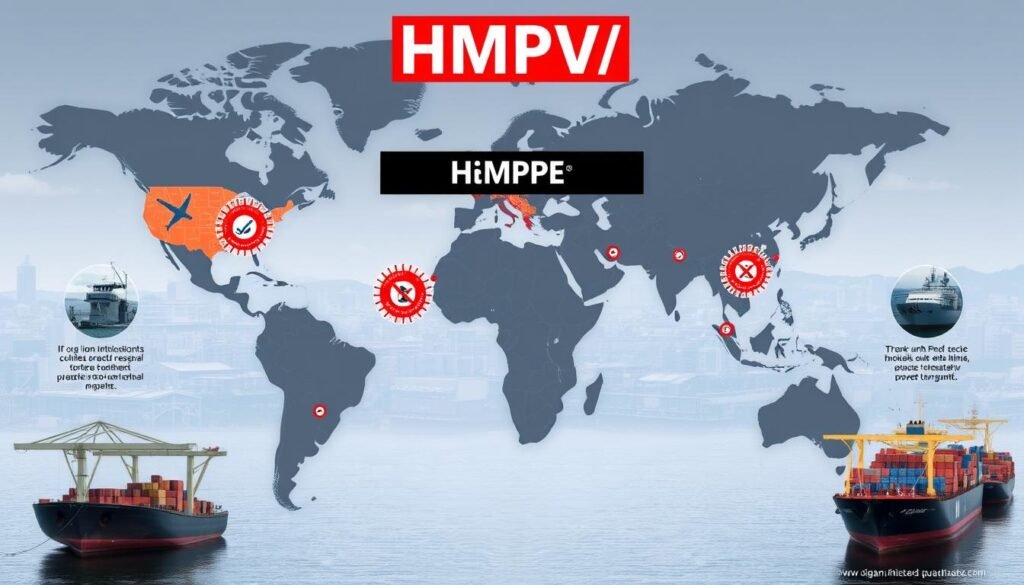
Latest Updates on Research and Development
Keeping up with the HMPV outbreak is key. Recent studies have revealed a lot about the virus. They’ve looked into how it spreads, its genetic makeup, and how our bodies react to it.
Breakthroughs have shown HMPV’s effects on certain groups, like the elderly and young kids. The research is moving forward, aiming to find better ways to stop and treat the virus. Continuous surveillance for viruses like HMPV is vital for health care.
Current Studies and Scientific Breakthroughs
Research is focusing on a few main areas:
- Looking into how hygiene can stop HMPV spread
- Creating fast tests to spot HMPV
- Working on vaccines
With no specific treatments for HMPV, prevention is key. This means using personal protection and environmental safety measures. Keeping up with new research and health advice is important.
Future Outlook
In the next few months, HMPV research will likely make big strides. We’ll see better treatments and ways to prevent the virus. By following the latest research, you’ll know more about HMPV and what’s coming next.
Conclusion
As we wrap up our look at the HMPV outbreak in China, it’s vital to understand this respiratory illness. Taking steps to prevent it is key. Even though it’s not a full-blown crisis yet, the increase in cases among kids and the elderly is a warning sign.
HMPV can be dangerous, mainly for those with weak immune systems or lung problems. Learning about its symptoms, how it spreads, and how to prevent it can help. This knowledge keeps you and your family safe.
Researchers and health experts are working hard to find better ways to diagnose and treat HMPV. Keeping up with the latest news is important. This way, you can be ready to face the challenges of the HMPV outbreak in China.
Your efforts to stop HMPV from spreading can really help. By keeping clean, staying away from crowded places, and getting medical help when needed, you play a big part. Together, we can fight this illness and keep everyone healthy.